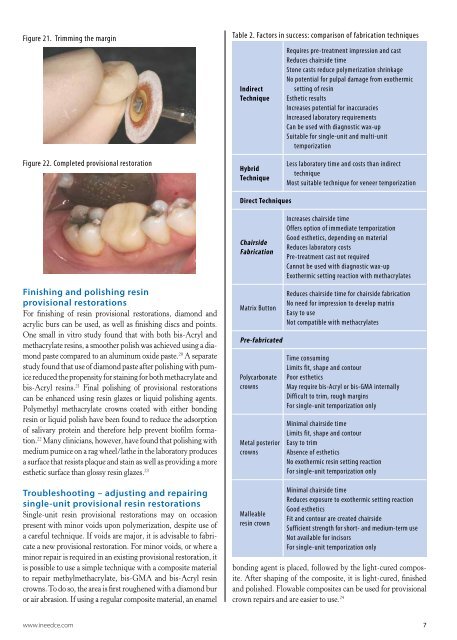Contemporary Temporization - IneedCE.com
Contemporary Temporization - IneedCE.com
Contemporary Temporization - IneedCE.com
You also want an ePaper? Increase the reach of your titles
YUMPU automatically turns print PDFs into web optimized ePapers that Google loves.
Figure 21. Trimming the margin<br />
Table 2. Factors in success: <strong>com</strong>parison of fabrication techniques<br />
Indirect<br />
Technique<br />
Requires pre-treatment impression and cast<br />
Reduces chairside time<br />
Stone casts reduce polymerization shrinkage<br />
No potential for pulpal damage from exothermic<br />
setting of resin<br />
Esthetic results<br />
Increases potential for inaccuracies<br />
Increased laboratory requirements<br />
Can be used with diagnostic wax-up<br />
Suitable for single-unit and multi-unit<br />
temporization<br />
Figure 22. Completed provisional restoration<br />
Hybrid<br />
Technique<br />
Less laboratory time and costs than indirect<br />
technique<br />
Most suitable technique for veneer temporization<br />
Direct Techniques<br />
Chairside<br />
Fabrication<br />
Increases chairside time<br />
Offers option of immediate temporization<br />
Good esthetics, depending on material<br />
Reduces laboratory costs<br />
Pre-treatment cast not required<br />
Cannot be used with diagnostic wax-up<br />
Exothermic setting reaction with methacrylates<br />
Finishing and polishing resin<br />
provisional restorations<br />
For finishing of resin provisional restorations, diamond and<br />
acrylic burs can be used, as well as finishing discs and points.<br />
One small in vitro study found that with both bis-Acryl and<br />
methacrylate resins, a smoother polish was achieved using a diamond<br />
paste <strong>com</strong>pared to an aluminum oxide paste. 20 A separate<br />
study found that use of diamond paste after polishing with pumice<br />
reduced the propensity for staining for both methacrylate and<br />
bis-Acryl resins. 21 Final polishing of provisional restorations<br />
can be enhanced using resin glazes or liquid polishing agents.<br />
Polymethyl methacrylate crowns coated with either bonding<br />
resin or liquid polish have been found to reduce the adsorption<br />
of salivary protein and therefore help prevent biofilm formation.<br />
22 Many clinicians, however, have found that polishing with<br />
medium pumice on a rag wheel/lathe in the laboratory produces<br />
a surface that resists plaque and stain as well as providing a more<br />
esthetic surface than glossy resin glazes. 23<br />
Troubleshooting – adjusting and repairing<br />
single-unit provisional resin restorations<br />
Single-unit resin provisional restorations may on occasion<br />
present with minor voids upon polymerization, despite use of<br />
a careful technique. If voids are major, it is advisable to fabricate<br />
a new provisional restoration. For minor voids, or where a<br />
minor repair is required in an existing provisional restoration, it<br />
is possible to use a simple technique with a <strong>com</strong>posite material<br />
to repair methylmethacrylate, bis-GMA and bis-Acryl resin<br />
crowns. To do so, the area is first roughened with a diamond bur<br />
or air abrasion. If using a regular <strong>com</strong>posite material, an enamel<br />
Matrix Button<br />
Pre-fabricated<br />
Polycarbonate<br />
crowns<br />
Metal posterior<br />
crowns<br />
Malleable<br />
resin crown<br />
Reduces chairside time for chairside fabrication<br />
No need for impression to develop matrix<br />
Easy to use<br />
Not <strong>com</strong>patible with methacrylates<br />
Time consuming<br />
Limits fit, shape and contour<br />
Poor esthetics<br />
May require bis-Acryl or bis-GMA internally<br />
Difficult to trim, rough margins<br />
For single-unit temporization only<br />
Minimal chairside time<br />
Limits fit, shape and contour<br />
Easy to trim<br />
Absence of esthetics<br />
No exothermic resin setting reaction<br />
For single-unit temporization only<br />
Minimal chairside time<br />
Reduces exposure to exothermic setting reaction<br />
Good esthetics<br />
Fit and contour are created chairside<br />
Sufficient strength for short- and medium-term use<br />
Not available for incisors<br />
For single-unit temporization only<br />
bonding agent is placed, followed by the light-cured <strong>com</strong>posite.<br />
After shaping of the <strong>com</strong>posite, it is light-cured, finished<br />
and polished. Flowable <strong>com</strong>posites can be used for provisional<br />
crown repairs and are easier to use. 24<br />
www.ineedce.<strong>com</strong> 7

















